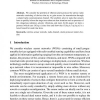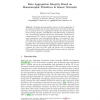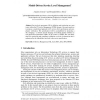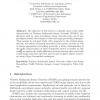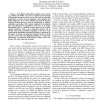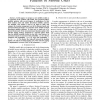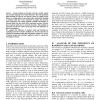ADHOCNOW
2010
Springer
14 years 1 months ago
2010
Springer
Random walks in wireless sensor networks can serve as fully local, very simple strategies for sink motion that reduce energy dissipation a lot but increase the latency of data coll...
ADHOCNOW
2010
Springer
14 years 1 months ago
2010
Springer
We consider the problem of efficient alarm protocol for ad-hoc radio networks consisting of devices that try to gain access for transmission through a shared radio communication ch...
ADHOCNOW
2010
Springer
14 years 1 months ago
2010
Springer
Designing message integrity schemes for data aggregation is an imperative problem for securing wireless sensor networks. In this paper, we propose three secure aggregation schemes ...
AIMS
2010
Springer
14 years 1 months ago
2010
Springer
Service-level agreements (SLA) definition and monitoring are open issues within the IT Service Management (ITSM) domain. Our main goals are to propose a model-based approach to IT ...
EURONGI
2008
Springer
14 years 1 months ago
2008
Springer
The objective of this work is to identify some of the traffic characteristics of Wireless Multimedia Sensor Networks (WMSN). Applications such as video surveillance sensor networks...
EURONGI
2008
Springer
14 years 1 months ago
2008
Springer
Current mobility management systems are operator centralized, and focused on single link technologies. In heterogeneous wireless mesh networks, vertical handovers could be a length...
EURONGI
2008
Springer
14 years 1 months ago
2008
Springer
In traditional channelized multiple access systems, e.g., TDMA and FDMA, each user is assigned a fixed amount of bandwidth during the whole service time, and the teletraffic perfor...
EURONGI
2008
Springer
14 years 1 months ago
2008
Springer
In this paper, we propose a new mobility model as an extension of the random walk model. Our proposal gathers mobility patterns with several degrees of randomness, so that both ran...
EURONGI
2008
Springer
14 years 1 months ago
2008
Springer
EURONGI
2008
Springer
14 years 1 months ago
2008
Springer
The guaranteed delivery of critical data is an essential requirement in most Wireless Sensor Network (WSN) applications. The paucity of energy, communication, processing and storag...

